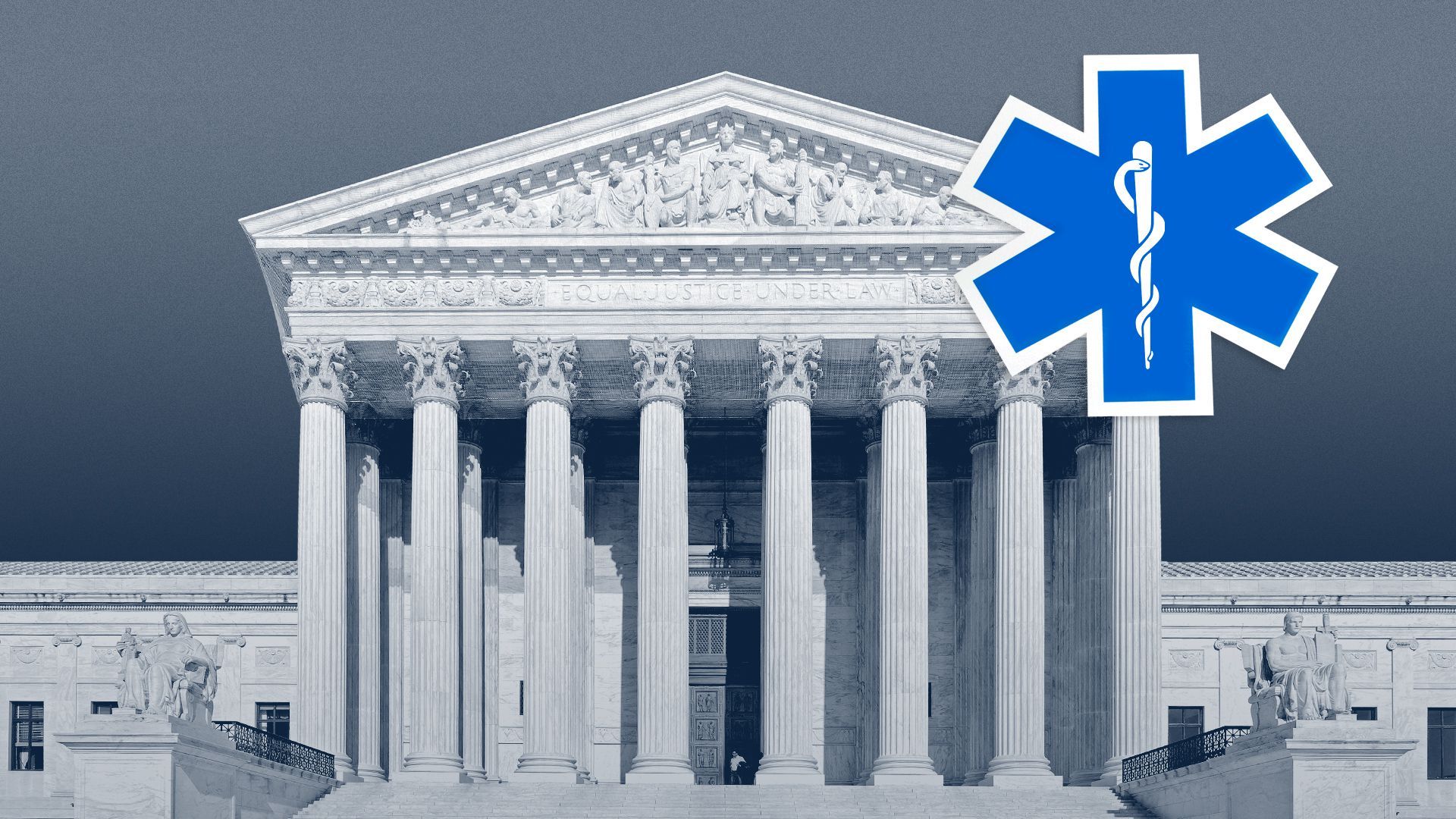| |
| |
| |
| Presented By Blue Cross Blue Shield Association |
| |
| Axios Vitals |
| By Tina Reed · Jun 16, 2022 |
| Good morning, Vitals readers. Today's newsletter is 1,092 words or a 4-minute read. 🍺 1 fun thing: Turns out drinking a beer — whether it contains alcohol or not — could help men's gut microbes, a study published in the American Chemical Society's Journal of Agricultural and Food Chemistry found. - Reality check: This was a super small study and men consumed 11 ounces of a lager — not even a full can — with their dinner for four weeks. But we still found the findings intriguing...
|
| |
| |
| 1 big thing: A pandemic milestone approaches |
 |
|
| Illustration: Aïda Amer/Axios |
| |
| Parents of infants and toddlers are a big step closer to having front-line protection against COVID after a key FDA committee on Wednesday unanimously recommended authorizing vaccines for kids as young as 6 months. Why it matters: The shots will start going into little arms as early as next week if the FDA and CDC follow through on the recommendation. What they're saying: "This is a huge milestone in the pandemic, not because it changes the trajectory of the virus but because of the way we as a country can think about where we are," Leana Wen, an emergency physician and a professor at George Washington University, told Axios. - "Right now, there are so many parents who have not themselves been able to resume their pre-pandemic lives. There are many families who have put off gatherings or travel or other aspects of normal life," Wen said. "This allows millions of families to change the way they perceive where they are."
Yes, but: But expanding access to the youngest Americans may not reduce the overall spread since parents have already shown hesitancy in getting older kids vaccinated. - The American Academy of Pediatrics estimates 8.2 million, or just more than a third of kids (36%) ages 5 to 11 have gotten at least one of their COVID-19 vaccination shots as of June 8.
- And 14.8 million U.S. kids ages 12 to 17 (59%) have gotten at least one COVID shot.
Go deeper. |
    |
| |
| |
| 2. Hospitals' big win |
 |
|
| Illustration: Shoshana Gordon/Axios |
| |
| A unanimous U.S. Supreme Court sided with hospital groups on Wednesday in a closely watched dispute over whether the federal government had the authority to cut facilities' payments for outpatient drugs, Axios' Adriel Bettelheim writes. Why it matters: The case, brought by the American Hospital Association and other hospitals, involved billions of dollars in payments and tested how much deference courts should give federal agencies when laws are vague. Details: Hospitals can pocket large savings when acquiring certain drugs through a federal discount drug program called 340B. - Medicare, under the Trump administration, instituted a 28.5% cut to those drug payments starting in 2018. Research indicated some hospitals were profiting excessively from the program.
- But the justices ruled the rate adjustment ran afoul of the law, because HHS didn't conduct a survey of hospitals' acquisition costs.
What they're saying: "HHS will now have to more carefully follow the text and structure of statutes rather than relying on assumed court deference to the agency," wrote Raymond James analyst Chris Meekins in a note. Between the lines: The unanimous opinion written by Justice Brett Kavanaugh didn't directly address the so-called Chevron doctrine, which says federal agencies like Medicare have some leeway to interpret ambiguous laws, and courts should defer to them. The bottom line: The ruling leaves unresolved the bigger policy question of how to tailor federal support for hospitals that disproportionately care for underserved populations, said University of Pennsylvania law professor Allison Hoffman. |
    |
| |
| |
| 3. Prescription-free birth control push |
 |
|
| Illustration: Allie Carl/Axios |
| |
| The nation's biggest physicians group is joining calls for the FDA to make birth control pills accessible over the counter, Axios' Arielle Dreher writes. Why it matters: With abortion rights in flux, physicians are joining reproductive health advocates in urging increased access to oral contraceptives, which could join already approved emergency contraceptives, like Plan B, on pharmacy shelves. - "It takes on a new urgency as we look down the path of having the loss of the right to abortion in this country," Dana Singiser, co-founder of the Contraceptive Access Initiative, told Axios.
Details: The American Medical Association at its annual meeting opted to follow the American College of Obstetricians and Gynecologists and urge the FDA to make birth control pills available over-the-counter to Americans, without an age restriction. - Two drug companies have been in discussions with the FDA for years to bring their birth control pills to this point, the New York Times reported last year.
- The AMA expects HRA Pharma to formally apply to the FDA for over-the-counter clearance before the end of the year. It completed its final testing phase in 2021.
|
    |
| |
| |
| A message from Blue Cross Blue Shield Association |
| Congress: Finish the fight for affordable care |
| |
 |
| |
| As health care costs rise, families deserve the peace of mind that comes with access to affordable health care. Blue Cross and Blue Shield companies are committed to lowering the cost of care – for the health of America. Next steps: Congress needs to finish the fight to make care more affordable. |
| |
| |
| 4. The heavy weight of America's medical debt |
| More than 100 million Americans have medical debt as part of a far more pervasive problem within U.S. health care than has previously been reported, an investigation published today by Kaiser Health News and NPR shows. Why it matters: Even as the system creates debt on a mass scale, much of the money that's owed is hidden in the form of credit card balances, loans from family members or payment plans with hospitals, per KHN and NPR. The details: A KFF poll found a quarter of those with debt owe $5,000 or more and nearly 20% of respondents with any medical debt said they didn't expect to ever pay it off. - "Debt is no longer just a bug in our system. It is one of the main products," said Rishi Manchanda, a physician who has worked with low-income patients in California for more than a decade and served on the board of the nonprofit RIP Medical Debt, told KHN and NPR.
|
    |
| |
| |
| 5. Medicare's data problem |
| The race and ethnicity data Medicare collects on its beneficiaries is less accurate for such groups as American Indians, Asian-Pacific Islanders and Hispanics, limiting the program's ability to assess health disparities, Adriel writes about a federal audit. Why it matters: Inaccuracies can undercut efforts to address inequities and measure results. - The pandemic underscored sharp disparities among Medicare beneficiaries, with Black, Hispanic and American Indians accounting for disproportionately high rates of cases and hospitalizations.
Go deeper: Medicare's primary source for race and ethnicity information is Social Security data, even though it's limited to only a few categories and missing for 3.3 million beneficiaries, the HHS inspector general's office reported in the audit. - Medicare administrators applied an algorithm to improve visibility that relies on a list of names frequently associated with Asian-Pacific Islanders and Hispanic individuals.
- But even after applying the algorithm, 1.3 million beneficiaries still have "Unknown" or missing information, while another 600,000 are categorized as "Other," the inspector general found.
What's ahead: The program is taking steps like incorporating race and ethnicity questions that are consistent with the HHS standards and is expanding use of an alternative algorithm. - The inspector general suggested Medicare also develop a way to collect race and ethnicity information from beneficiaries when they enroll and to incorporate the existing data from the nursing home and other post-acute care assessments that have more race and ethnicity categories.
|
    |
| |
| |
| A message from Blue Cross Blue Shield Association |
| As health care costs rise, it's time for more affordable care |
| |
 |
| |
| As health care costs rise, families deserve the peace of mind that comes with access to affordable health care. Blue Cross and Blue Shield companies are committed to lowering the cost of care – for the health of America. Next steps: Congress needs to finish the fight to make care more affordable. |
| |
 | It's called Smart Brevity®. Over 200 orgs use it — in a tool called Axios HQ — to drive productivity with clearer workplace communications. | | |







No comments:
Post a Comment